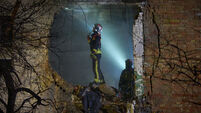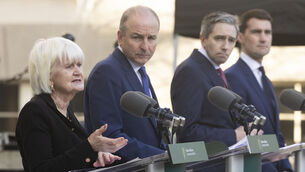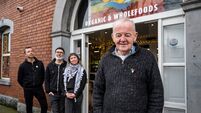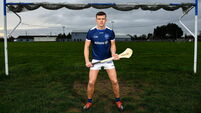Was it Ab Fab for you?
Yet now that plans are afoot to resurrect the much-loved BBC ’90s comedy, we may soon find out.
Recently, it was announced that the champers-quaffing, designer-worshipping pair would return to screens after a six-year absence. In a recent magazine interview star Joanna Lumley commented: “In late August I start filming on three episodes of Absolutely Fabulous, which we are all ecstatic about.”
As fashion editor/PR royalty, Edina and Patsy famously lived a life full to the brim full of glamour, boozy lunches, ligs and launches. But soon the question arises — just how close to reality was this gilded version of magazine publishing?
Three Irish women’s magazine editors from the Ab Fab days talk about publishing before the internet, the freebies, and rubbing designers up the wrong way…
Morag Prunty had been editing women’s magazines in Britain and arrived to Ireland in 1991. That year, she became editor of Irish Tatler, and later began writing popular fiction.
During the early ’90s, Irish magazines were being made on a shoestring budget. However, the PR industry was in spectacularly rude health. Best of all, they had money to lavish on journalists. “I once figured that my entire budget for Irish Tatler, including salaries, was equivalent to one fashion shoot in Elle,” she recalls. “And they were renowned for paying poorly, because of the high kudos involved in being in the magazine. The industry really took off in Ireland in the late ’80s and there was a lot of money sloshing around.
“In Britain you’d be lucky to get tea and a biscuit, but PR agents here would take us out to La Stampa and Patrick Guilbaud’s restaurant almost every day. You’d be put up in nice hotels and sent on nice trips.
“There were very small salaries but the perks were good. There were discounts on fashion, free hairdos, socialising on PR slates. All that stuff that matters when you’re 21. I didn’t buy a lipstick until the year 2000 when I quit the magazine.”
Another perhaps less obvious perk to the job was the invaluable insight beyond the smoke and mirrors of fashion magazines.
“I never looked at models and wished to be them, for instance,” she says. “Most of the time they’re just tall, thin girls, and being that way isn’t always easy. It’s much harder than it looks, and people are constantly judging them on how they look.”
Minuscule budgets aside, putting the magazine together was a labour-intensive process. There was no Googling and no taking leads from fashion blogs, for a start. “We had to get the photographers to send in the pictures from fashion shows, unless you went to the shows, which happened rarely,” she explains. “You talked to people and went places. In fact, I wrote most of the magazine myself.”
As for the long-held notion that fashion mags are a bitchy, cut-throat environment, Prunty admits: “The Devil Wears Prada did strike a chord in Britain, not so much in Ireland, but when that film came out, I was on the editor’s side. I saw this scruffy thing (Anne Hathaway’s character) walk in and thought: ‘God, I’d never hire her’.”
Jane McDonnell was editor of Image Magazine from 1989 until 2005, She had previously worked under Beatrix Miller and Anna Wintour at Vogue, placing her in a perfect position to take over the magazine. Now, she is the publisher of The Gloss magazine.
A science graduate from Trinity College, McDonnell’s career trajectory has been as thrilling as it has been unlikely. She moved to London and landed a job at Vogue magazine before being offered the job of editor at Image. She worked there for 15 years (as editor and managing director) and during her time there also established Image Interiors.
“There was huge competition in Britain and the glossies became a significant business,” she recalls. “When I came home to edit Image, Ireland was still depressed and Dublin was not especially vibrant in terms of the fashion business or photography. The biggest issues were budget and lack of activity. The magazine worked alongside Irish photographers and models, and we invested a bit in photography to elevate the standards of the visuals. The writing was always brilliant but sometimes the visuals lacked a bit of sparkle.”
Alas, McDonnell rarely felt able to avail of the many perks on offer to fashion magazine journalists at the time. “The perks were there, but when you’re putting together a magazine there wasn’t the time to indulge,” she says. “An unspoken view at Vogue was that once you took the perks, your integrity was blown to some extent.”
Referring to one of her most glamorous, ‘pinch-me’ career moments, McDonnell recalls a trip to Paris to see a Christian Lacroix show: “We put up at the Bristol hotel. There was a Lacroix fragrance piped into the rooms through the vents, which was pretty impressive.
“The magazine was resolutely Irish,” she explains. “It was, ultimately, our unique selling point. But no-one wants to read something that’s parochial, so we had to be mindful of that.”
Needless to say, McDonnell learned plenty at the hem of doyennes like Miller and Wintour.
“I completely related to the myths, in fact I’d seen many of them first hand,” she says. “Anna was called Nuclear Wintour at the time. I used to bring The Book, as it’s called, over to her apartment, though someone else picked up the dry cleaning. I remember the shades worn at lunchtime as she ate her scrambled eggs.
“She was terrifying, but there was a meritocracy in effect there. She awarded people who delivered. I like to think I brought that back to Image.”
As one of Ireland’s first ‘It’ girls, Noelle Campbell-Sharp owned and edited Irish Tatler from 1979 to 1988. During her tenure, she changed the title to IT, and also bought Social & Personal before selling IT onto Michael Smurfit. She currently runs Cill Rialaig, an artists’ haven in Kerry, and the Origin Gallery in Dublin.
Ireland may have been in the throes of a recession while Campbell-Sharp ran IT, but the party continued unabated in Dublin.
“There was the nightclub Barbarella’s which was the Krystle of its time, and Elizabeth’s on Leeson Street and Joy’s on Baggot Street,” recalls Campbell-Sharp. “People didn’t write about society in the same way they do now, mainly because the journalists felt that they were part of the party. I went out to promote the magazines I owned and to ensure journalists would be paid their wages.”
A social staple, Campbell-Sharp moved in the same circles as famed social diarist Terry Keane.
“Initially, Terry and I hated each other. Lots of journalists would show up to where we were just to see if one of us would have a hissy fit. I made up with Terry, mainly after I embraced her from behind as I thought she was someone else. But in the end she became my great friend. We went everywhere in the world. I’d call her on the Monday and say: ‘We’re going to Cairo on the Friday’.”
And, as the pair globe-trotted in the name of ‘work’, there were many moments of mischief: “I was in Paris for a Valentino party with Terry. We were in the suite next to Valentino and one night he had a breakfast card outside his hotel room door. Terry took it and ticked off everything on it. The morning later, all we could hear were screams through the wall as 20 breakfasts were delivered to his room.”
There were also many trips to exotic locales for fashion shoots, “but they weren’t expensive, mainly because we’d get free travel if I promoted the travel agency.”
She recalls a trip to St Moritz with model Jean O’Reilly and her husband, photographer Neil Campbell-Sharp. It being the topsy-turvy world of fashion, the model found herself dressed up to the nines on a snowy mountainside.
“Jean was wearing a Patrick Howard sequin dress and these blue suede shoes,” says Campbell-Sharp. “We were not dressed for the mountainside and we tried to book into a restaurant. Then we saw these huge clouds gathering and an American climber told us another avalanche was on its way. So we pretty much slid down the mountain.”
It was also, perhaps crucially, a time before Photoshop, and the models felt huge pressure.
“One model had her back teeth removed so she would have higher cheekbones, and had a procedure done on her kneecaps so she would have better looking legs. The (models) saw their body as a product they had to sell.”
However, Campbell-Sharp views today’s technology as more hindrance than help. “There was much more creativity back then,” she says. “We thought we were inventors every day. Magazines today seem very boring ... there is nothing new. Now, there’s so much derivative stuff going on, and there’s not as much fun in copying someone as there is in being original.”
And if anyone knows that, it’s Noelle Campbell-Sharp.
* Absolutely Fabulous will be shown on BBC1 later this year.















